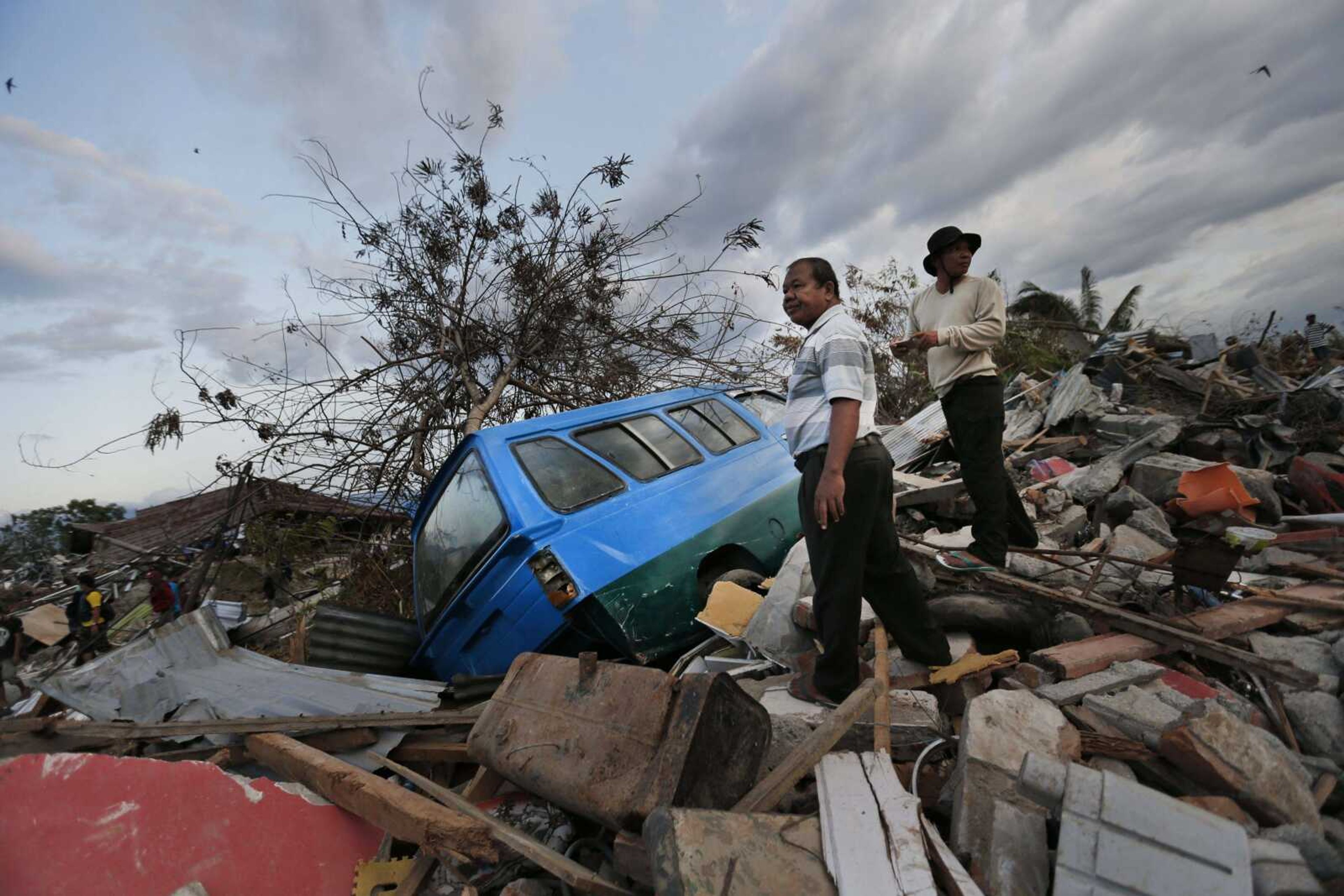Area hit hard by quake seen as high-risk zone
PETOBO, Indonesia -- When the violent shaking from a massive magnitude 7.5 earthquake finally stopped, Selvi Susanti stood up and realized something strange was happening. First, she saw the ground suddenly begin to sink. Then the pavement split beneath her feet like a broken dinner plate and started to rise...
PETOBO, Indonesia -- When the violent shaking from a massive magnitude 7.5 earthquake finally stopped, Selvi Susanti stood up and realized something strange was happening. First, she saw the ground suddenly begin to sink. Then the pavement split beneath her feet like a broken dinner plate and started to rise.
Terrified, she clung to a small sliver of asphalt and surfed a river of fast-moving mud as it swallowed entire neighborhoods, carrying her higher than coconut trees for a quarter of a mile.
"What I saw -- oh my God! Houses were tumbling. They started to roll like waves. It's like a tsunami, but the difference was they were waves of soil," said Susanti, 38, weeping at the memory of seeing so many people simply disappear into the earth as they screamed for help. "It felt like I was in a boat, moving around. But the difference is I was not in water, but in the mud."
Many, like Susanti in the devastated village of Petobo, had no idea they were in an area already identified by the government as a high-risk zone for the devastating geological phenomenon causing soft ground to liquefy during earthquakes.
But Indonesian scientist Gegar Prasetya wasn't surprised by any of the events of Sept. 28, killing nearly 2,000 people and leaving possibly thousands more missing. He had warned people for years the area around Sulawesi island's Palu Bay had been struck before and was due for another potential combination of factors to create a perfect storm capable of unleashing earthquakes, landslides, tsunami waves and soil liquefaction.
"I knew right away," said Prasetya, co-founder of the Tsunami Research Center Indonesia, who had met with government officials and residents in the area to try to raise awareness about the threat. "I posted in our group, and I said, 'It's happened."'
Disaster-prone Indonesia, part of the Pacific Basin's "Ring of Fire," is an archipelago of about 17,000 islands sitting atop numerous fault lines producing some of the largest and most deadly earthquakes, tsunamis and volcanic eruptions in recorded history.
Other scientists around the world wondered how this type of earthquake -- on a strike-slip fault, which typically does not produce dangerous tsunamis -- could generate waves that surged as high as 20 feet.
Again, Prasetya knew.
He had published a paper nearly two decades ago highlighting six other tsunamis recorded in the Makassar Strait in the past century, predicting a repeat event could be expected roughly every 25 years. The last one occurred in a region north of the city in 1996. Before that, Palu Bay was hit in 1968 by a very similar magnitude 7.4 quake that generated waves 33 feet high.
"This one complete village went to the sea," he said of the 1968 event. "You can still see the trees from the top of the water."
Some experts theorize the Sept. 28 quake, by itself, didn't generate a big wave despite being shallow and near the coast. They're convinced it was instead the area's soft soil serving as the real catalyst for disaster.
The temblor's long, violent shaking likely triggered one or more underwater landslides due to unstable sediment deposited on the seafloor by rivers. This disruptive movement may have created the large wall of water racing across the open ocean until being squeezed into the long, narrow bay that surrounds Palu, forcing the wave to grow higher.
"Imagine what happens if you drop a brick in a flat pond -- ripples spread in all directions," said Robert Hall, a geologist at Royal Holloway University of London, who has studied the area. "Now drop the same size object in a bathtub. The waves can reflect off the sides, can amplify and may get larger in the direction of the length of the bath."
But it wasn't just weak sediment in the ocean that gave way. Wet, sandy soil also separated and came alive through liquefaction in some areas due to the earthquake's radical vibrations. The ground simply lost its strength and turned to mush beneath people's feet, creating mud acting like quicksand. People, houses, cars and streets were swallowed and covered by a thick carpet of what -- just seconds earlier -- had been solid earth. Fast-moving landslides also were launched above ground, possibly causing even more localized tsunami waves.
"We wouldn't necessarily expect to get all the worst possible factors occurring together," said Willem De Lange, a scientist from the University of Waikato in New Zealand who co-authored research on the area with Prasetya in 2001. "Unfortunately this does happen."
Many questions remain about exactly what happened in this complex disaster. Prasetya will begin field work with the Indonesian navy this week to try to better understand what occurred under water, and a team of international experts are expected to arrive next month to carry out an assessment.
Connect with the Southeast Missourian Newsroom:
For corrections to this story or other insights for the editor, click here. To submit a letter to the editor, click here. To learn about the Southeast Missourian’s AI Policy, click here.








